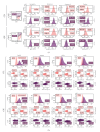Exploration of the lysis mechanisms of leukaemic blasts by chimaeric T-cells
- PMID: 20617141
- PMCID: PMC2896659
- DOI: 10.1155/2010/234540
Exploration of the lysis mechanisms of leukaemic blasts by chimaeric T-cells
Abstract
Adoptive transfer of specific cytotoxic T lymphocytes (CTL) and Cytokine Induced Killer Cells (CIK) following genetic engineering of T-cell receptor zeta hold promising perspective in immunotherapy. In the present work we focused on the mechanisms of anti-tumor action of effectors transduced with an anti-CD19 chimaeric receptor in the context of B-lineage acute lymphoblastic leukemia (B-ALL). Primary B-ALL blasts were efficiently killed by both z-CD19 CTL and z-CD19 CIK effectors. The use of death receptor mediated apoptosis of target cells was excluded since agonists molecules of Fas and TRAIL-receptors failed to induce cell death. Perforin/granzyme pathway was found to be the mechanism of chimaeric effectors mediated killing. Indeed, cytolytic effector molecules perforin as well as granzymes were highly expressed by CTL and CIK. CD19 specific stimulation of transduced effectors was associated with degranulation as attested by CD107 membrane expression and high IFN-gamma and TNF-alpha release. Moreover inhibitors of the perforin-based cytotoxic pathway, Ca(2+)-chelating agent EGTA and Concanamycin A, almost completely abrogated B-ALL blast killing. In conclusion we show that the cytolysis response of z-CD19 chimaeric effectors is predominantly mediated via perforin/granzyme pathway and is independent of death receptors signaling in primary B-ALL.
Figures





References
-
- Pui CH, Schrappe M, Ribeiro RC, Niemeyer CM. Childhood and adolescent lymphoid and myeloid leukemia. Hematology. 2004:118–145. - PubMed
-
- Loren AW, Porter DL. Donor leukocyte infusions for the treatment of relapsed acute leukemia after allogeneic stem cell transplantation. Bone Marrow Transplantation. 2008;41(5):483–493. - PubMed
-
- Biagi E, Marin V, Attianese GMPG, Dander E, D’Amico G, Biondi A. Chimeric T-cell receptors: new challenges for targeted immunotherapy in hematologic malignancies. Haematologica. 2007;92(3):381–388. - PubMed
-
- Pule MA, Straathof KC, Dotti G, Heslop HE, Rooney CM, Brenner MK. A chimeric T cell antigen receptor that augments cytokine release and supports clonal expansion of primary human T cells. Molecular Therapy. 2005;12(5):933–941. - PubMed
-
- Brentjens RJ, Santos E, Nikhamin Y, et al. Genetically targeted T cells eradicate systemic acute lymphoblastic leukemia xenografts. Clinical Cancer Research. 2007;13(18):5426–5435. - PubMed
Publication types
MeSH terms
Substances
LinkOut - more resources
Full Text Sources
Research Materials
Miscellaneous

